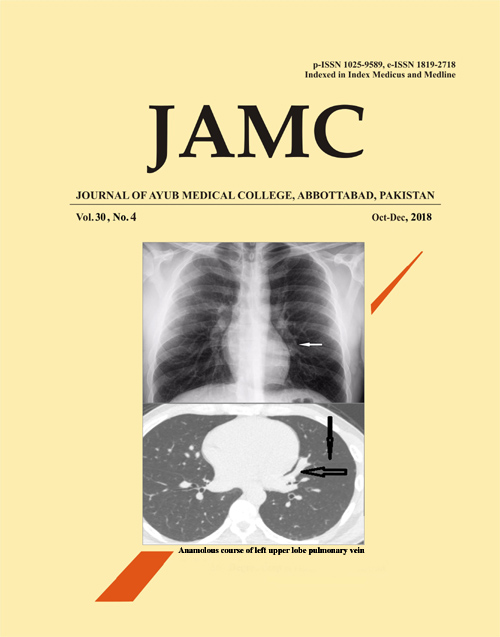COMPARISON OF SIMULTANEOUS VERSUS DELAYED VENTRICULOPERITONEAL SHUNTING IN PATIENTS UNDERGOING MENINGOCOELE REPAIR IN TERMS OF INFECTION
Abstract
Background: Myelomeningocele is a congenital anomaly of Central Nervous System (CNS) leading to serious sequels related to various systems and organs of the affected patient. Hydrocephalus is a common condition associated with myelomeningocele. Hydrocephalus is seen in 11.8% of children with Myelomeningocele (MMC). This study was conducted to compare the simultaneous vs delayed ventriculoperitoneal shunting in children undergoing myelomeningocele in terms of infection. Methods: This Randomized Control Trial was conducted at department of Neurosurgery, Ayub Medical College, Abbottabad from 7th March to 7th June 2016. In this study a total of 98 patients with MMC and hydrocephalus were randomly divided into two equal groups. In group A simultaneous MMC repair and VP shunting was performed while in group B MMC repair was done in first and VP shunting was done two weeks postoperatively. Results: In this study mean age in Group A was 1 years with SD±2.77 while mean age in Group B was 1 years with SD±3.12. In Group A (12%) patients had infection and (88%) whereas in Group B (20%) patients had infection and (80%) patients didn't had infection. Conclusion: Simultaneous VP shunting was more effective than delayed VP shunting in children undergoing myelomeningocele in terms of infection.
Keywords: Myelomeningocoele; spina bifida; delayed ventriculoperitoneal shunting; infection; complicationReferences
Warf BC. Hydrocephalus associated with neural tube defects: characteristics, management, and outcome in sub-Saharan Africa. Childs Nerv Syst 2011;27(10):1589-94.
Adzick NS, Thom EA, Spong CY, Brock JW 3rd, Burrows PK, Johnson MP, et al. A Randomized Trial of Prenatal versus Postnatal Repair of Myelomeningocele. N Engl J Med 2011;364(11):993-1004.
Sinha SK, Dhua A, Mathur MK, Singh S, Modi M, Ratan SK. Neural tube defect repair and ventriculoperitoneal shunting: indications and outcome. J Neonatal Surg 2012;1(2):21.
Arslan M, Eseoglu M, Gudu BO, Demir I, Kozan A, Gokalp A, et al. Comparison of simultaneous shunting to delayed shunting in infants with myelomeningocele in terms of shunt infection rate. Turk Neurosurg 2011;21(3):397-402.
Akalan N. Myelomeningocele (open spina bifida) - surgical management. Childs Nerv Syst 2013, 29:1569-79.
Yilmaz A, Müslüman AM, Dalgıc N, Çavuşoğlu H, Kanat A, Çolak I, et al. Shunt insertion in newborns with myeloschisis/myelomenigocele and hydrocephalus. J Clin Neurosci 2010;17(12):1493-96.
Januschek E, Röhrig A, Kunze S, Fremerey C, Wiebe B, Messing-Jünger M. Myelomeningocele - a single institute analysis of the years 2007 to 2015. Childs Nerv Syst 2016;32(7):1281-7
Miller PD, Pollack IF, Pang D, Albright AL. Comparison of simultaneous versus delayed ventriculoperitoneal shunt insertion in children undergoing myelomeningocele repair. J Child Neurol 2005;11(5):370-2.
Caldarelli M, Di Rocco C, La Marca F: Shunt complications in the first postoperative year in chıldren with meningomyelocele. Childs Nerv Syst 1996 Dec;12(12):748-54.
Saadai P, Farmer DL. Fetal surgery for myelomeningocele. Clin Perinatol. 2012;39(2):279-88.
Downloads
Published
How to Cite
Issue
Section
License
Journal of Ayub Medical College, Abbottabad is an OPEN ACCESS JOURNAL which means that all content is FREELY available without charge to all users whether registered with the journal or not. The work published by J Ayub Med Coll Abbottabad is licensed and distributed under the creative commons License CC BY ND Attribution-NoDerivs. Material printed in this journal is OPEN to access, and are FREE for use in academic and research work with proper citation. J Ayub Med Coll Abbottabad accepts only original material for publication with the understanding that except for abstracts, no part of the data has been published or will be submitted for publication elsewhere before appearing in J Ayub Med Coll Abbottabad. The Editorial Board of J Ayub Med Coll Abbottabad makes every effort to ensure the accuracy and authenticity of material printed in J Ayub Med Coll Abbottabad. However, conclusions and statements expressed are views of the authors and do not reflect the opinion/policy of J Ayub Med Coll Abbottabad or the Editorial Board.
USERS are allowed to read, download, copy, distribute, print, search, or link to the full texts of the articles, or use them for any other lawful purpose, without asking prior permission from the publisher or the author. This is in accordance with the BOAI definition of open access.
AUTHORS retain the rights of free downloading/unlimited e-print of full text and sharing/disseminating the article without any restriction, by any means including twitter, scholarly collaboration networks such as ResearchGate, Academia.eu, and social media sites such as Twitter, LinkedIn, Google Scholar and any other professional or academic networking site.










